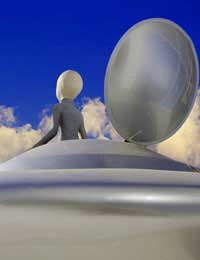Project Bluebook and After

1947 was the year it all happened – the Roswell crash in New Mexico and the Kenneth Arnold sighting in Washington which gave rise to the term “flying saucer,” both occurred within two weeks of one another. The UFO phenomenon was born. It zoomed into the public consciousness and dominated newspaper headlines. As guardians of the nation’s air space, which apparently was being penetrated at will by craft of unknown origin, people naturally turned to the Air Force. Military spokesmen found themselves being bombarded with questions from aggrieved journalists and anxious members of the public.
Military Investigations of UFOs Before Blue Book
In response, the Air Force commissioned the first in a series of formal investigations of the UFO phenomenon. Under the label of Project Sign, sometimes also known as Project Saucer, it concluded that UFOs were extra-terrestrial vehicles. When the project’s final report was sent to General Hoyt Vandenberg, the Air Force Chief of Staff, he promptly ordered it destroyed. Another investigation was commissioned under the name of Project Grudge. Grudge took a different tack and tended to disparage every sighting report, and offer up some conventional explanation instead. Grudge was wound up when a new wave of UFO sightings in late 1951 sparked some genuine interest among the military top brass. It was decided that a really serious investigation was now in order. In 1952, Project Blue Book was born.Project Blue Book
Captain Edward J. Ruppelt was the director of Project Blue Book in the years 1952-53. Ruppelt was scrupulously impartial about his approach to investigation. He removed members of staff he felt were too credulous or too skeptical, and he arranged for data on UFO sightings to be collected and stored in a more formal way. Indeed, it was he who came up with the term Unidentified Flying Object as a replacement for the less formal “flying saucer.”In a book he later wrote about his experiences, The Report on Flying Saucers, he recalled a change in attitude among the higher-ups about the phenomenon. From considering the possibility that the UFOs might be real, the military moved towards a more hardline position that there was nothing of substance there: apparent UFOs, they insisted, usually had conventional explanations such as meteors, weather balloons, ball lightning, etc. Ruppelt’s staff was reduced to only two, and his budget was cut. He soon asked for re-assignment.
After Ruppelt’s tenure, Blue Book continued for sixteen more years. But its approach became increasingly dismissive. The number of sightings classified as “unidentified” reduced dramatically, and it appeared that Blue book staff had been given instructions to bend over backwards to come up with an explanation of any UFO sighting report that came in, however strained or absurd it might seem.
As the sixties rolled on, Project Blue book increasingly earned the scorn of UFO researchers, newspaper reporters willing to take the subject seriously, and even its own scientist, J. Allen Hynek. Many felt that a cover-up was being perpetrated and that Blue Book was now more of a propaganda agency rather than an investigative organisation.
End and Aftermath of Project Blue Book
The Air Force wound up Project Blue Book in 1969. In total, 12,618 sightings had been reported to Project Blue Book and 718 were classed as “unidentified.” Despite this, the Air Force concluded that there was no evidence that UFOs represented any threat to the United States, embodied a state of scientific knowledge more advanced than our own, or were vehicles of extra-terrestrial origin.Project Blue Book’s Chief Scientist was J. Allen Hynek, an esteemed professor of astronomy from the University of Chicago. Hynek had initially been skeptical about UFOs, but as his investigations proceeded, his skepticism waned. It simply could not hold up against the accumulating quantity of evidence. In the end, Hynek became a firm believer that there was an underlying reality to the UFO mystery.
When Project Blue Book wound up, Hynek’s interest in the UFO subject continued. In 1973 he founded the Centre for UFO Studies in Chicago in an attempt to put the study of the UFO phenomenon on a more serious, scientific footing.


Re: The Truth About Alien Implants In Human Bodies
And It Exactly the same materials that are now insider C-19 shots. Quinta Columna explain This with video…
Re: Billy Meier
What about the 100+ witnesses to various phenomena, the metal alloys, beamship sounds? I think you should include more facts to improve your article.…
Re: The Truth About Alien Implants In Human Bodies
Hi, recently, I’ve received an implant in my inner ankle area, right below my ankle bone. It is curious to…
Re: The Dyfed Mystery
I sure a ufo in Wales England in January lthis year omg
Re: Walter Haut's Deathbed Roswell Confession
Anyone who has any doubts that Roswell happened should read Philip Corso's book. I am so glad he mentioned it in…
Re: The Truth About Alien Implants In Human Bodies
Hi, how do I contact Dr Roger Leir or his assistant Dr Steven Colbern for their urgent help of illegal…
Re: The Truth About Alien Implants In Human Bodies
Hello my name is Mike.Here the past week or so I've been having a reoccurring dream of when I was 10 or…
Re: The Truth About Alien Implants In Human Bodies
Hey there.. i have one experience before 20-23 years ago. I see 2 aliens one my bed and they put…
Re: The Truth About Alien Implants In Human Bodies
Second event. I was choking, being moved by several individuals dressed in white surgical gowns and full…
Re: The Falkirk Triangle
Its interesting to hear of UFO reports in Scotland but do people realise that UFO reports like we hear today just simply didn't exist…